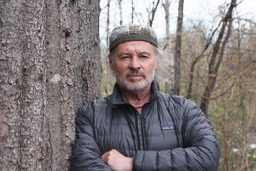.JPG) Gallery visitors listen to the recording of Nadia Myre's A
Gallery visitors listen to the recording of Nadia Myre's A
Casual Reconstruction at the opening reception of
Deconstructing Comfort at Open Space.
Photo credit: Kirk Schwartz.
The formation of a rainbow is a magical moment. Rays of sun, drops of rain, sky and clouds, land, and the human eye all come together in an Aiminanu (which means “a conversation is in progress,” in the Innu-aimun language).
A similarly magic moment occurred on a micro-scale during the Colour of Words workshop at the Primary Colours/Couleurs primaires gathering. Upstairs in our small meeting room, I actually had the feeling of riding on the back of Yandiäwish, the Great Turtle. That’s because the workshop attracted artists of such varied backgrounds—Indigenous, Francophone, city dwellers, and nomads—to talk literature and to create poetry together.
That’s what delighted me about the workshop. Palestinian Yara El Ghabdan, author of l’Ombre de l’olivier and Le parfum du Nour was in fine form. Rodney Saint-Éloi, publisher of Mémoire d’encrier brought the freshly-minted second edition of the Aimititau-Parlons-Nous! collection. His Haitian origin allowed him to speak with authority about the humanity of the word “Negro” as a way to express his fascination for the poetic dimension of words, which form the basis of literature.
That’s when, as a Wendat from the snowy north, I had a vision of a rainbow. It covered the island of the great black ravens and was made up of the Trickster figures found in tales of the Indigenous people from the Pacific Coast, the Wild North of Sioui, the black South of Saint-Éloi and the bitter Middle East of El Ghabdan. Added to this, the astonishing mixed-race Francophile sensibility of Oceania in the person of Léuli Mazyar Luna’i Eshrāghi, a member of the Samoan Kulin Nation and of Persian origin.
It was as if East, West, North and South were joined together by the power and the colour of words. And what might have been a mere discussion, developed into a two-part play based on the aromas of sensuality and the fragrances of the imaginary that make up art.
Around our little table, Rodney Saint-Éloi set the tone as he calmly addressed passion, triggered by certain words, a passion that inhabits the lands where these words take root. Léuli Mazyar Luna’i Eshrāghi, a Samoan francophone born into an anglicized Oceania, colourfully described his marginal and nomadic existence travelling to the four corners of the world. Our exchange was further enriched by Yara’s upbeat and worldly-wise comments.
Rodney then suggested that we read a passage from our books— a sort of performance art—in order to bring The Colour of Words to life. And so, for a brief moment, we switched personas. Yara El Ghabdan became a Wendat and read from Rêves et Révolte, an excerpt from my exchanges with Québec poet Yves Boisvert published in Aimititau-Parlons-Nous! And I became a symbolic Palestinian as I softly recited a beautiful excerpt from Yara’s latest novel, which left us savouring the smell of coffee on an imaginary morning.
This is how I remember the The Colour of Words workshop. In some ways, it was a prime example of the overarching objective of the Primary Colours/Couleurs primaires gathering: to break down barriers!
Translated by Don Sugden, reviewed by Breanna Fabbroy

Guy Sioui Durand is a Wendat (Huron) based in Wendake, Québec, Canada. He is a sociologist (PhD), art critic, independent curator, and performer (spoken word). He is specialized in contemporary Aboriginal art and contemporary art. Sioui Durand is curating the project Hommage aux Skywalkers/Ironworkers Mohawks from the event Rassemblement Internations d’Art Performance Autochtone (RIAPA) in Wendake this September 14-16, 2018. He is preparing the exhibition De Tabac, de Sauge et de Foins d’odeurs for the Joliette Museum of Art for winter 2019. Sioui Durand teaches "Initiation to Modern and Contemporary Aboriginal Art" at the Kiuna Native Institution, the only completely Aboriginal post-secondary institution.